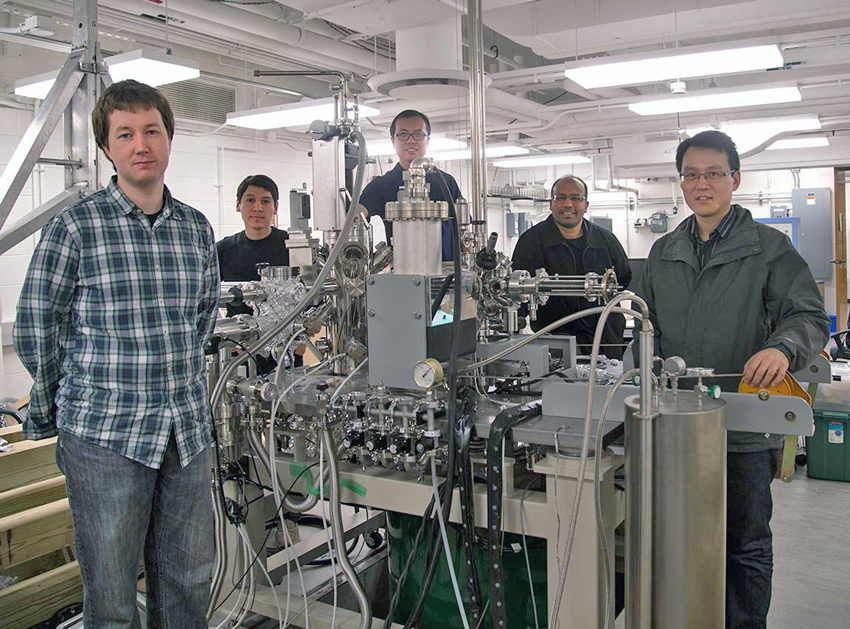An international team led by Princeton University scientists has discovered an elusive massless particle first theorized 85 years ago: the Weyl fermion. It was detected as an emergent quasiparticle in synthetic crystals of the semimetal, tantalum arsenide (TaAs). Using angle-resolved photoemission spectroscopy (ARPES), the researchers studied the surface and bulk band structure of TaAs. The results exhibit the features—cones, nodes, and arcs—that establish the presence of Weyl fermions. These exotic particles, if applied to next-generation electronics, could allow for the nearly free and efficient flow of electricity, and thus greater power, in devices such as computers. More generally, the work paves the way for the realization of many fascinating topological quantum phenomena.

Weyl fermions were proposed by the mathematician and physicist Hermann Weyl in 1929 as an alternative to Einstein’s theory of relativity. Although that application never panned out, the characteristics of his theoretical particle intrigued physicists for nearly a century. Unlike electrons, Weyl fermions are massless and possess a high degree of mobility. They also possess a form of chirality in which their spin is either in the same direction as motion (right-handed) or in the opposite direction (left-handed). Their basic nature means that Weyl fermions move very quickly on the surface of the crystal with no backscattering, which hinders efficiency and generates heat in normal electronic materials.
According to established theory, a Weyl semimetal state could only arise in a crystal where either time-reversal symmetry or inversion symmetry is broken. Initially, the team researched hundreds of crystal structures and simulated dozens of likely structures. They published an earlier paper theorizing that Weyl fermions could exist in a class of materials composed of a transition metal (e.g. Ta or Nb) and a Group 15 element (e.g. As or P). They synthesized asymmetrical TaAs crystals and brought them to the ALS (Beamlines 4.0.3, 10.0.1, and 12.0.1) as well as other synchrotron light sources (Stanford Synchrotron Radiation Lightsource, Diamond Light Source, and the Swiss Light Source) to perform ARPES experiments.
Using a combination of vacuum ultraviolet (VUV) and soft x-ray (SX) ARPES, the researchers systematically studied the surface and bulk electronic structure of TaAs. The surface-sensitive VUV-ARPES measurements demonstrated the existence of Fermi-arc surface states, consistent with earlier band calculations. The SX-ARPES measurements, which are reasonably bulk sensitive, revealed 3D (bulk) Weyl cones with linear dispersions, similar to the 2D (surface) Dirac cones associated with topological insulators and graphene. When the tips of the cones overlap slightly, there is no bandgap, and the material is considered a semimetal (insulators and semiconductors have bandgaps). When the tips meet at a single point, it is a Weyl semimetal, and the point is called a Weyl node.

Superimposing the SX-ARPES bulk data containing the Weyl nodes onto the VUV-ARPES data containing the surface Fermi arcs to scale, the researchers noted that all the arc terminations and projected Weyl nodes match within the experimental resolution. Because the SX-ARPES bulk data and the VUV-ARPES surface data are completely independent measurements obtained at two different beamlines, the fact that they match well provides another piece of evidence of the topological nature (the surface–bulk correspondence) of the Weyl semimetal state in TaAs.
Although practical technologies are still a long way off, publications about Weyl fermions have increased rapidly since the discovery was reported, signifying the opening of an exciting new frontier in condensed matter physics. “The physics of the Weyl fermion are so strange,” said M. Zahid Hasan, the Princeton physics professor who led the research team, “there could be many things that arise from this particle that we’re just not capable of imagining now.”

Contact: M. Zahid Hasan
Research conducted by: S.-Y. Xu, I. Belopolski, N. Alidoust, G. Bian, H. Zheng, D.S. Sanchez, P.P. Shibayev, and M.Z. Hasan (Princeton Univ.); M. Neupane (Princeton Univ. and Los Alamos National Laboratory); C. Zhang and Z. Yuan, (Peking Univ.); R. Sankar and F. Chou (National Taiwan Univ.); G. Chang, C.-C. Lee, S.-M. Huang, and H. Lin (National Univ. of Singapore); J. Ma (Oak Ridge National Laboratory); B.K. Wang (National Univ. of Singapore and Northeastern Univ.); A. Bansil (Northeastern Univ.); and S. Jia (Peking Univ. and Collaborative Innovation Center of Quantum Matter, Beijing).
Research funding: Gordon and Betty Moore Foundation; Singapore National Research Foundation; National Basic Research Program of China; Taiwan Ministry of Science and Technology; and the U.S. Department of Energy (DOE), Office of Basic Energy Sciences (BES). Operation of the ALS is supported by DOE BES.
Publications about this research: S.-Y. Xu, I. Belopolski, N. Alidoust, M. Neupane, G. Bian, C. Zhang, R. Sankar, G. Chang, Z. Yuan, C.-C. Lee, S.-M. Huang, H. Zheng, J. Ma, D.S. Sanchez, B.K. Wang, A. Bansil, F. Chou, P.P. Shibayev, H. Lin, S. Jia, and M.Z. Hasan, “Discovery of a Weyl fermion semimetal and topological Fermi arcs,” Science 349, 613 (2015); and S.-M. Huang, S.-Y. Xu, I. Belopolski, C.-C. Lee, G. Chang, B.K. Wang, N. Alidoust, G. Bian, M. Neupane, C. Zhang, S. Jia, A. Bansil, H. Lin, and M. Z. Hasan, “A Weyl Fermion semimetal with surface Fermi arcs in the transition metal monopnictide TaAs class,” Nat. Commun. 6, 7373 (2015).
ALS SCIENCE HIGHLIGHT #320